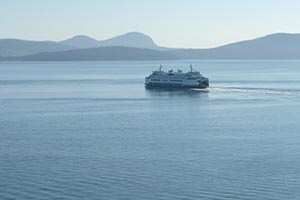Monitoring Puget Sound from ferries
In an effort to better understand water quality in Puget Sound, we've installed oceanographic sensors on ferries that cross Puget Sound regularly bringing cars and passengers across the water.
Since 2009, sensors on the privately owned Victoria Clipper ferry have been measuring phytoplankton concentrations and temperature across hundreds of miles between Seattle and Victoria, B.C., Canada. That system is currently offline, but it will return soon.
We're also studying how the Pacific Ocean influences ocean acidification and declining oxygen levels in Puget Sound and the Strait of Juan de Fuca. In 2013, we partnered with the Applied Physics Laboratory at the University of Washington to install instruments on Washington State Ferries to measure the velocities of currents across the entrance to Puget Sound. This information supports numerical models of Puget Sound and informs water quality management decisions.
So, if you are riding the ferry to or from Port Townsend, you should know that below deck, our instruments are also hitching a ride, collecting data to help Puget Sound.
Assessing conditions while crossing the Salish Sea
Measurements taken from ferries help scientists understand the circulation and exchange of Puget Sound and Pacific Ocean waters.
Our marine scientists have developed creative approaches to collecting data. We collect continuous high-frequency water-surface measurements along a transect crossing the Salish Sea from 47.5° to 48.5 °N. Our sensors aboard the Victoria Clipper IV passenger ferry that makes twice daily runs between Seattle and Victoria, B.C. measure geo-referenced chlorophyll a, turbidity, colored dissolved organic matter, salinity, and temperature. These observations record key features such as water masses, river plumes, and algal blooms. We compare these data with monthly samples from our nearby monitoring stations.
Since 2013, instruments on Washington State Ferries provide surface-to-bottom measurements of current velocities across Admiralty Reach multiple times a day. These data will help us understand and manage water quality — such as low dissolved oxygen, algal blooms, and ocean acidification — by quantifying oceanic intrusions into Puget Sound.
Sonar on the Sound
We've outfitted the Washington State Ferries with Acoustic Doppler Current Profilers, or ADCPs, installed on the hulls. The sonar system measures currents from the surface all the way to the bottom.
ADCPs send sound waves (pings) down through the water column beneath the ferry as it is underway. The time it takes for the echoes to return to the ADCP is used to calculate the speed and direction (velocity) of the water flowing under the ferry.
These sensors, which primarily measure current velocities in a continuous transect along the ferry route, provide unprecedented surface-to-bottom measurements of water-mass movement and transport between basins. That information in turn will help scientists track nutrients and water masses with low-oxygen that could harm aquatic life.
Data from the water surface
We deployed a Turner Designs C3 fluorometer in a water intake onboard the Victoria Clipper ferry. This instrument is now offline awaiting upgrades in a new boat. It will be back in service soon. Ususally, the sensor provides measurements of:
- Chlorophyll fluorescence (to monitor algae abundance).
- Turbidity (to monitor water clarity).
- Temperature (to monitor water circulation and habitat conditions).
- Colored Dissolved Organic Matter (CDOM) fluorescence (to monitor river and stormwater discharge).
Ferry data can be used to calibrate ocean color satellite images which provide estimates of chlorophyll, CDOM, and suspended sediment concentrations, and other indices of algae abundance.
Data from ferries
In situ sensors mounted to moving ferries offer high precision and excellent temporal resolution. The advantages of this approach is to measure processes to complement our long-term marine flight program. Data for scientists are available:
For more information on gaining access to data, please contact Julianne Ruffner at julianne.ruffner@ecy.wa.gov or 360-280-4518.
In situ sensors offer a unique insight into environmental processes and complement our long-term marine monitoring flight programs. Their strength resides in quantifying the dynamic of patterns with high temporal variability such as tides, oceanic low-oxygen intrusions, and storms. Both flight and ferry data need to be evaluated side-by-side as part of a larger marine monitoring effort. We share information with our marine monitoring partners for an improved understanding of our marine environment.
Puget Sound ferry monitoring publications
- Quality Assurance Monitoring Plan — Puget Sound Temperature, Salinity, In Situ Fluorescence, Turbidity, and Colored Dissolved Organic Matter Marine Water Monitoring using the Victoria Clipper IV Ferry Vessel
- Quality Assurance Project Plan — Ferry-Based Monitoring of Puget Sound Currents
- Poster — Using Ferries For Marine Water Quality Monitoring In The Salish Sea
- Poster — Ecosystem thresholds in surface waters of the Salish Sea using continuous measurements from ferry sensors
- Poster — Physical, Chemical, and Biological Conditions during Noctiluca Blooms in an Urban Fjord, Puget Sound
Related links
Contact information
Julianne Ruffner
Monitoring Unit Supervisor
julianne.ruffner@ecy.wa.gov
360-280-4518


